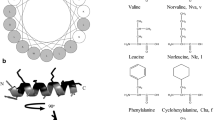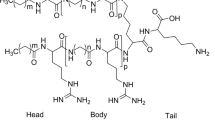Abstract
Multidrug-resistant bacteria present an important threat to human health. In this study, due to the weak antimicrobial activity of chensinin-1b against multidrug-resistant (MDR) bacteria, three lipo-chensinin-1b peptides, including OA-C1b, LA-C1b and PA-C1b, were designed and their activities against MDR bacteria were examined. Both the OA-C1b and LA-C1b peptides exhibited potent antimicrobial activity against selected multidrug-resistant bacterial strains. In addition to the direct disruption of bacterial membranes by antimicrobial peptides, it has also been proposed that DNA is a superior intracellular target for antimicrobial peptides. ctDNA was used as a model to investigate the binding properties of DNA and lipo-chensinin-1b peptides using a variety of biophysical methods. The kinetics results of both UV-Vis and CD spectroscopy suggested that the interaction between lipo-chensinin-1b peptides and ctDNA was concentration-dependent and resulted in an increase in polynucleotide helicity. Viscosity measurements, Trp fluorescence and iodide quenching experiments indicated that nonclassical groove binding and electrostatic binding interaction modes were utilized when the peptides interacted with the ctDNA. In addition, the formation of peptide-ctDNA complexes was monitored using dynamic light scattering experiments, during which the peptide exhibited the ability to neutralize the negative charges on the surface of the ctDNA. These results promote the possibility of designing peptide-based antibiotics targeted to DNA.








Similar content being viewed by others
References
Walsh C (2000) Molecular mechanisms that confer antibacterial drug resistance. Nature 406:775–781
Levy SB (1998) Multidrug resistance--a sign of the times. N Engl J Med 338:1376–1378
Lewis K (2013) Platforms for antibiotic discovery. Nat Rev Drug Discov 12:371–387
Zasloff M (2002) Antimicrobial peptides of multicellular organisms. Nature 415:389–395
Yang L, Harroun TA, Weiss TM, Ding L, Huang HW (2001) Barrel-stave model or toroidal model? A case study on melittin pores. Biophys J81:1475–1485
Pouny Y, Rapaport D, Mor A, Nicolas P, Shai Y (1992) Interaction of antimicrobial dermaseptin and its fluorescently labeled analogues with phospholipid membranes. Biochemistry 31:12416–12423
Matsuzaki K, Murase O, Fujii N, Miyajima K (1996) An antimicrobial peptide, magainin 2, induced rapid flip-flop of phospholipids coupled with pore formation and peptide translocation. Biochemistry 35:11361–11368
Ding L, Yang L, Weiss TM, Waring AJ, Lehrer RI, Huang HW (2003) Interaction of antimicrobial peptides with lipopolysaccharides. Biochemistry 42:12251–12259
Li Y, Qi X, Zhang Q, Huang Y, Su Z (2012) Overview on the recent study of antimicrobial peptides: origins, functions, relative mechanisms and application. Peptides 37:207–215
Sun Y, Dong W, Sun L, Ma L, Shang D (2015) Insights into the membrane interaction mechanism and antibacterial properties of chensinin-1b. Biomaterials 37:299–311
Park CB, Kim HS, Kim SC (1998) Mechanism of action of the antimicrobial peptide buforin II: buforin II kills microorganisms by penetrating the cell membrane and inhibiting cellular functions. Biochem Biophys Res Commun 244:253–257
Boman HG, Agerberth B, Boman A (1993) Mechanisms of action on Escherichia coli of cecropin P1 and PR-39, two antibacterial peptides from pig intestine. Infect Immun 61:2978–2984
Gupta RC, Spencer-Beach G (1996) Natural and endogenous DNA adducts as detected by 32P-postlabeling. Regul Toxicol Pharmacol 23:14–21
Tennant AH, Peng B, Kligerman AD (2001) Genotoxicity studies of three triazine herbicides: in vivo studies using the alkaline single cell gel (SCG) assay. Mutat Res 493:1–10
Boer DR, Canals A, Coll M (2009) DNA-binding drugs caught in action: the latest 3D pictures of drug-DNA complexes. Dalton Trans:399–414
Pindur U, Jansen M, Lemster T (2005) Advances in DNA-ligands with groove binding, intercalating and/or alkylating activity: chemistry, DNA-binding and biology. Curr Med Chem 12:2805–2847
Upadhyay SK (2017) Binding and thermodynamics of REV peptide-ctDNA interaction. Biopolymers 108:e22902
Mukherjee A, Mondal S, Singh B (2017) Spectroscopic, electrochemical and molecular docking study of the binding interaction of a small molecule 5H-naptho[2,1-f][1,2] oxathieaphine 2,2-dioxide with calf thymus DNA. Int J Biol Macromol 101:527–535
Zhang G, Zhang Y, Zhang Y, Li Y (2013) Spectroscopic studies of cyanazine binding to calf thymus DNA with the use of ethidium bromide as a probe. Sensor Actuat B-Chem 182:453–460
Dong W, Liu Z, Sun L, Wang C, Guan Y, Mao X, Shang D (2018) Antimicrobial activity and self-assembly behavior of antimicrobial peptide chensinin-1b with lipophilic alkyl tails. Eur J Med Chem 150:546–558
Pal T, Abraham B, Sonnevend A, Jumaa P, Conlon JM (2006) Brevinin-1BYa: a naturally occurring peptide from frog skin with broad-spectrum antibacterial and antifungal properties. Int J Antimicrob Agents 27:525–529
Park NG, Lee S, Oishi O, Aoyagi H, Iwanaga S, Yamashita S, Ohno M (1992) Conformation of tachyplesin I from tachypleus tridentatus when interacting with lipid matrices. Biochemistry 31:12241–12247
Beckloff N, Laube D, Castro T, Furgang D, Park S, Perlin D, Clements D, Tang H, Scott RW, Tew GN, Diamond G (2007) Activity of an antimicrobial peptide mimetic against planktonic and biofilm cultures of oral pathogens. Antimicrob Agents Chemother 51:4125–4132
Dong W, Mao X, Guan Y, Kang Y, Shang D (2017) Antimicrobial and anti-inflammatory activities of three chensinin-1 peptides containing mutation of glycine and histidine residues. Sci Rep 7:40228
van der Wal A, Minor M, Norde W, Zehnder AJB, Lyklema J (1997) Electrokinetic potential of bacterial cells. Langmuir 13:165–171
Shang D, Meng X, Zhang D, Kou Z (2017) Antibacterial activity of chensinin-1b, a peptide with a random coil conformation, against multiple-drug-resistant Pseudomonas aeruginosa. Biochem Pharmacol 143:65–78
Pathak N, Salas-Auvert R, Ruche G, Janna MH, McCarthy D, Harrison RG (1995) Comparison of the effects of hydrophobicity, amphiphilicity, and alpha-helicity on the activities of antimicrobial peptides. Proteins. 22:182–186
Brogden KA (2005) Antimicrobial peptides: pore formers or metabolic inhibitors in bacteria? Nat Rev Microbiol 3:238–250
Kawasaki H, Koyama T, Conlon JM, Yamakura F, Iwamuro S (2008) Antimicrobial action of histone H2B in Escherichia coli: evidence for membrane translocation and DNA-binding of a histone H2B fragment after proteolytic cleavage by outer membrane proteinase T. Biochimie 90:1693–1702
Subastri A, Ramamurthy CH, Suyavaran A, Mareeswaran R, Lokeswara Rao P, Harikrishna M, Suresh Kumar M, Sujatha V, Thirunavukkarasu C (2015) Spectroscopic and molecular docking studies on the interaction of troxerutin with DNA. Int J Biol Macromol 78:122–129
Shahabadi N, Maghsudi M (2014) Multi-spectroscopic and molecular modeling studies on the interaction of antihypertensive drug; methyldopa with calf thymus DNA. Mol BioSyst 10:338–347
Fu XB, Liu DD, Lin Y, Hu W, Mao ZW, Le XY (2014) Water-soluble DNA minor groove binders as potential chemotherapeutic agents: synthesis, characterization, DNA binding and cleavage, antioxidation, cytotoxicity and HSA interactions. Dalton Trans:8721–8737
Sirajuddin M, Ali S, Badshah A (2013) Drug–DNA interactions and their study by UV–visible, fluorescence spectroscopies and cyclic voltametry. J Photochem Photobiol B 124:1–19
Dong W, Sun Y, Shang D (2015) Interactions between chensinin-1, a natural antimicrobial peptide derived from Rana chensinensis, and lipopolysaccharide. Biopolymers 103:719–726
Erkkila KE, Odom DT, Barton JK (1999) Recognition and reaction of metallointercalators with DNA. Chem Rev 99:2777–2799
Mati SS, Roy SS, Chall S, Bhattacharya S, Bhattacharya SC (2013) Unveiling the groove binding mechanism of a biocompatible naphthalimide-based organoselenocyanate with calf thymus DNA: an “ex vivo” fluorescence imaging application appended by biophysical experiments and molecular docking simulations. J Phys Chem B 117:14655–14665
Ranjbar B, Gill P (2009) Circular dichroism techniques: biomolecular and nanostructural analyses- a review. Chem Biol Drug Des 74:101–120
Bhattacharya S, Mandal SS (1997) Interaction of surfactants with DNA. Role of hydrophobicity and surface charge on intercalation and DNA melting. Biochim Biophys Acta 1323:29–44
Zhou X, Zhang G, Wang L (2014) Probing the binding mode of psoralen to calf thymus DNA. Int J Biol Macromol 67:228–237
Macías B, Villa MV, Lapresa R, Alzuet G, Hernández-Gil J, Sanz F (2012) Mn(II) complexes with sulfonamides as ligands. DNA interaction studies and nuclease activity. J Inorg Biochem 115:64–71
Shah A, Zaheer M, Qureshi R, Akhter Z, Nazar MF (2010) Voltammetric and spectroscopic investigations of 4-nitrophenylferrocene interacting with DNA. Spectrochim Acta A Mol Biomol Spectrosc 75:1082–1087
Dong W, Dong Z, Mao X, Sun Y, Li F, Shang D (2016) Structure-activity analysis and biological studies of chensinin-1b analogues. Acta Biomater 37:59–68
Acknowledgements
This study was supported by the National Natural Science Foundation of China (31872225, 21502083 and 31672289), China Postdoctoral Science Foundation (2016 M601330), LiaoNing Revitalization Talents Program (XLYC1807251) and the funding from Dalian Science and Technology Bureau (2017RQ142).
Author information
Authors and Affiliations
Corresponding author
Ethics declarations
Conflict of Interest
The authors declare that they have no conflict of interest.
Additional information
Publisher’s Note
Springer Nature remains neutral with regard to jurisdictional claims in published maps and institutional affiliations.
Electronic supplementary material
ESM 1
(PDF 403 kb)
Rights and permissions
About this article
Cite this article
Dong, W., Luo, X., Sun, Y. et al. Binding Properties of DNA and Antimicrobial Peptide Chensinin-1b Containing Lipophilic Alkyl Tails. J Fluoresc 30, 131–142 (2020). https://doi.org/10.1007/s10895-019-02478-x
Received:
Accepted:
Published:
Issue Date:
DOI: https://doi.org/10.1007/s10895-019-02478-x




